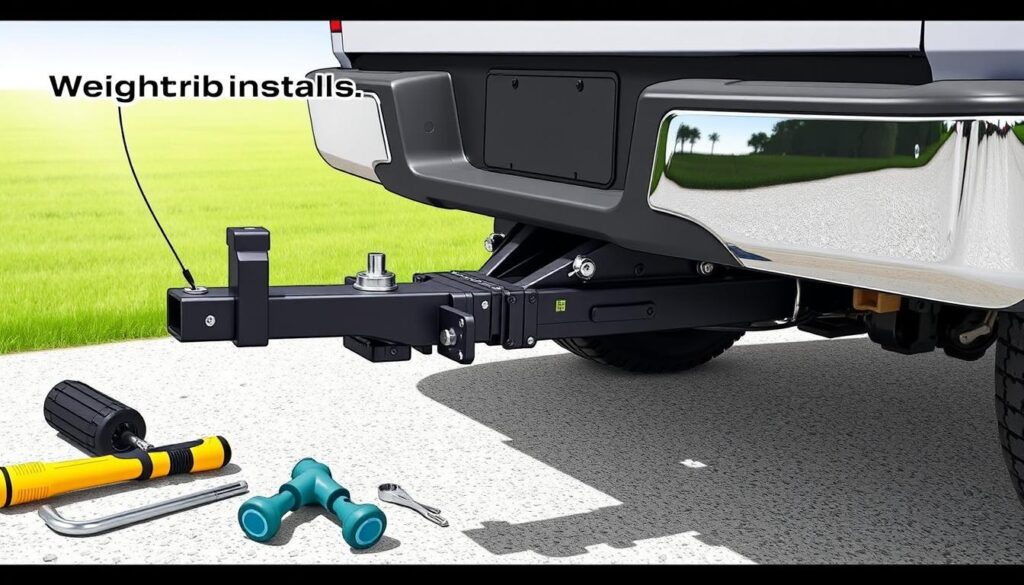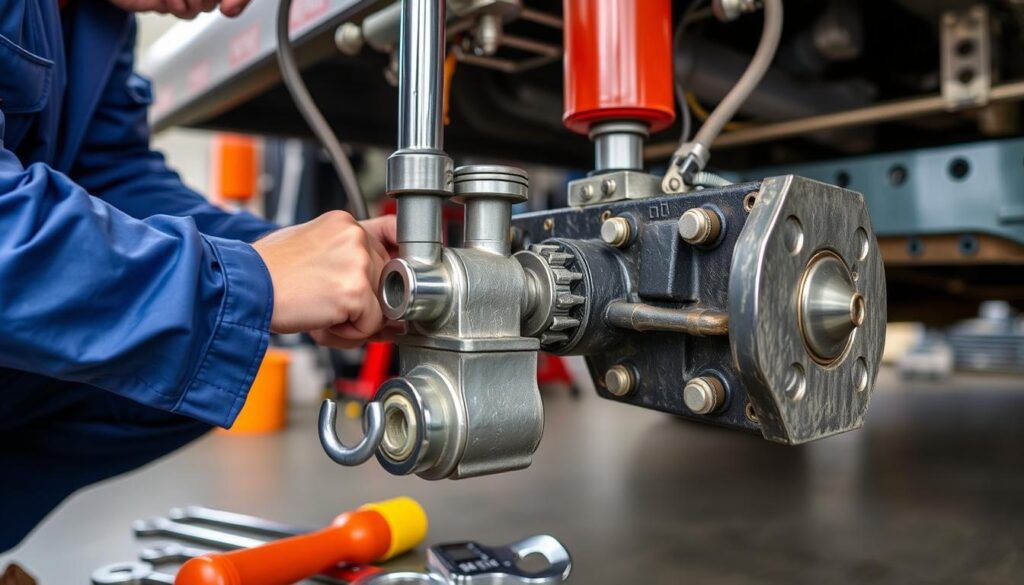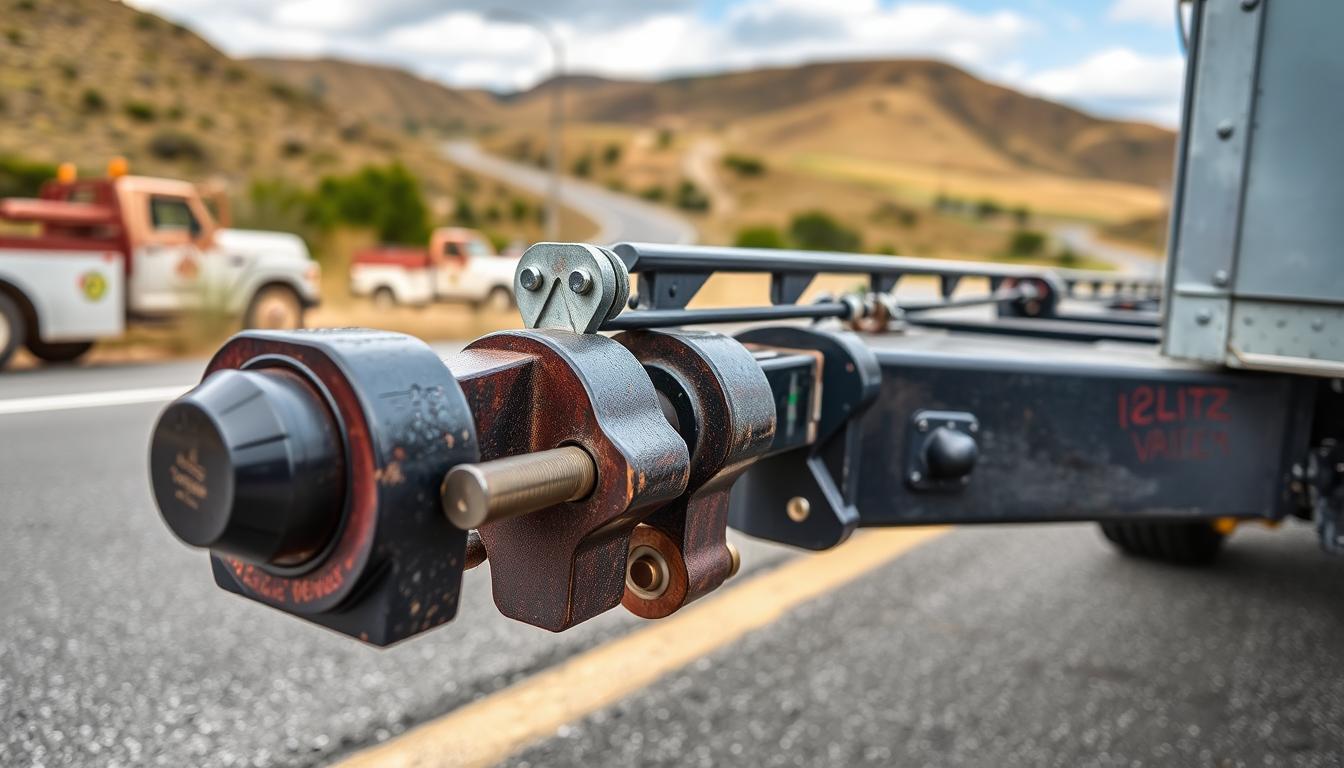A weight distribution hitch is key for towing safety. It spreads the trailer’s weight evenly, stopping trailer sway and making towing safer. This is vital for loads over 5,000 lbs, as the 2018 Chevy Traverse manual says.
This hitch works by tightening the spring bars. This counteracts the tongue weight, lowering sway risk and boosting safety.
These systems use round or trunnion bars to spread the weight. Most hitches have a 2-inch receiver for these systems. They aim for better balance and control, not to lift the towing limit.
Signs you need one include truck sag, trailer sway, and steering issues. Also, if you want to tow at the max, you might need one.
Key Takeaways
- A weight distribution hitch is essential for towing safety, when towing over 5,000 lbs.
- The hitch spreads the trailer’s weight evenly across the towing vehicle and trailer axles.
- Systems use round or trunnion bars to distribute weight.
- They apply tension to counteract tongue weight, reducing sway.
- Signs you need one include truck sag, trailer sway, and steering issues.
- These hitches don’t increase towing capacity but improve balance and control.
Understanding Weight Distribution Hitches
A weight distribution hitch spreads the trailer’s weight evenly. This is key when towing heavy loads. It stops trailer sway and makes towing safer. The weight distribution system uses springs and tension to balance the trailer’s weight.
When picking a hitch, think about the towing capacity of your vehicle. The hitch must handle the trailer’s weight and any extra cargo. A weight distribution hitch helps spread the trailer’s weight better. This lowers sway risk and boosts towing safety.
Knowing how weight distribution hitches work helps owners choose the right one. They’re vital for towing safely, whether it’s a big trailer or a small boat. They ensure a stable towing experience by evenly distributing the trailer’s weight.
Basic Principles of Weight Distribution
Weight distribution hitches use springs and tension to spread the trailer’s weight. This reduces sway risk and boosts towing safety. Understanding these principles helps owners pick the right hitch for their needs.
Components of a Weight Distribution Hitch System
A weight distribution hitch system is key for safe towing. It has a ball mount, hitch receiver, and spring bars. These parts work together for a smooth towing experience. The ball mount attaches to the tow vehicle, while the hitch receiver is on the vehicle’s underside. The spring bars keep the trailer in line with the vehicle.
This system spreads the trailer’s weight evenly. This is vital for towing heavy loads. It helps prevent trailer sway and makes towing safer. Setting it up right requires measuring the vehicle and trailer heights.
Choosing the right weight distribution hitch is important. It makes towing safer and more stable. Knowing what each part does helps owners pick the best equipment for their needs.
The Science Behind Weight Distribution Technology
Weight distribution technology is a complex system. It uses load distribution mechanics for a safe towing experience. By understanding it, owners can make better towing choices. It works by applying torque and leverage principles to spread trailer weight evenly.
The main goal is a safe towing experience. This is done through weight distribution technology, load distribution mechanics, and torque and leverage principles. It helps in controlling the vehicle and reduces sway risks.
Load Distribution Mechanics
Load distribution mechanics are key in weight distribution technology. Adjustable spring bars and tension help spread trailer weight. This reduces sway and improves safety.
Torque and Leverage Principles
Torque and leverage are vital in weight distribution technology. They help distribute trailer weight evenly. This ensures a stable and safe towing experience.
Weight Transfer Calculations
Calculating weight transfer is important for trailer loading. It helps ensure the trailer is loaded correctly. This reduces accident risks and improves safety.
Benefits of Using a Weight Distribution Hitch
Using a weight distribution hitch can greatly improve towing safety. It reduces the risk of trailer sway and boosts trailer stability. This is key when towing heavy loads, as it prevents accidents and makes towing better.
A weight distribution hitch spreads the weight evenly between the tow vehicle and trailer. This reduces trailer sway and improves towing safety. It uses spring bars and tension to distribute the weight, ensuring a stable towing experience. With it, towing becomes more stable and controlled, even in tough conditions.
Over 11% of U.S. households own an RV or recreational trailer, about 40 million people. RV sales soared during the COVID-19 pandemic, with many new to towing. A weight distribution hitch ensures a safe and fun towing experience for these newcomers.
A weight distribution hitch also improves handling and braking power. It spreads the weight evenly, reducing accident risks and making towing better. Its many benefits make it a must-have for trailer towing.
| Benefits of Weight Distribution Hitch | Description |
|---|---|
| Improved Towing Safety | Reduces the risk of trailer sway and improves trailer stability |
| Increased Stability | Evenly distributes the weight between the tow vehicle and trailer |
| Improved Handling | Makes it easier to navigate in adverse conditions |
| Enhanced Braking Power | Ensures the weight is evenly distributed, critical for safety during downhill travel or emergencies |
Selecting the Right Weight Distribution Hitch for Your Setup
Choosing the right weight distribution hitch is key for safe towing. When picking a hitch, think about weight ratings, trailer size, and if it fits your vehicle. This ensures a safe and balanced towing experience.
Understanding Weight Ratings
Weight ratings are vital when picking a hitch. The tongue weight should be 10-15% of the Gross Trailer Weight (GTW). Hitches are rated for tongue weight and GTW. For heavy loads, you might need a Class 3, 4, or 5 hitch with a weight distribution kit.
Matching Hitch to Trailer Size
To find the right hitch for your trailer, look at the weight range. Round Bar kits handle 600-1200 lbs tongue weight. Trunnion Bar kits go up to 1700 lbs. Andersen kits cover 200-1400 lbs. Make sure the hitch rating is higher than your GTW.
Compatible Vehicle Considerations
Make sure the hitch fits your vehicle. Check your vehicle’s towing capacity and hitch receiver class. The hitch should work well with your vehicle’s suspension and frame. This ensures the best weight distribution and towing stability.
| Hitch Type | Tongue Weight Range | Best For |
|---|---|---|
| Round Bar | 600-1200 lbs | Light to medium loads |
| Trunnion Bar | 600-1700 lbs | Heavier loads |
| Andersen | 200-1400 lbs | Versatile range |
Professional Installation vs DIY Setup
Choosing between professional installation and DIY setup for a weight distribution hitch is a big decision. It depends on your budget, experience, and how much time you have. Each option has its own benefits.
Going for professional installation means you get expert help. Prices can be from $100 to $600, and some jobs might cost up to $1,300. Experts use the right tools and know-how, making sure it’s done right. This is best for those new to towing or who aren’t handy.

DIY installation can be cheaper, with parts costing between $150 and $400. But, it takes time and requires tools and mechanical skills. You’ll need a floor jack, ratchet, and torque wrench. It’s important to follow instructions carefully and avoid common mistakes.
Think about your vehicle and trailer when making your choice. Trucks and SUVs might need more complex setups. Sedans with light trailers might do with simpler ones. Always remember, safety is key when towing, so don’t skimp on installation for the sake of saving money.
| Installation Type | Cost Range | Best For |
|---|---|---|
| Professional | $100 – $1,300 | Novices, complex setups |
| DIY | $150 – $400 (parts only) | Experienced, budget-conscious |
Proper Setup and Adjustment Procedures
Setting up a weight distribution hitch right is key for safe and effective towing. It involves several steps, from installing it to making final adjustments. By following these steps, your hitch will work well, keeping your towing stable and safe.
Initial Installation Steps
First, measure your vehicle and trailer heights. This is the base for making adjustments. Then, adjust the hitch head angle as the manual says. Remember, each hitch is different, so always check your manual.
Fine-tuning the System
To fine-tune, adjust the lift chains and the ball mount head tilt. You’ll need at least five chain links on each side for balance. Use washers to tweak the tilt, aiming for even weight on your vehicle’s axles.
Testing for Proper Distribution
After adjusting, test your setup. Re-measure your vehicle and trailer heights. This confirms the weight is evenly spread, making your towing safer and more stable.
| Setup Step | Key Action |
|---|---|
| Initial Measurement | Record vehicle and trailer heights |
| Hitch Head Adjustment | Set angle as per manufacturer’s guide |
| Chain Adjustment | Use minimum 5 links, equal on both sides |
| Final Testing | Re-measure to confirm proper distribution |
Common Problems and Troubleshooting
Weight distribution hitch issues can really affect towing safety and performance. It’s important to know and fix common problems to keep towing safe. Let’s look at some common issues and how to solve them.
Hitch misalignment is a big worry for RV owners. It can cause uneven weight and less stability. Troubleshooting often means adjusting the hitch height and making sure it’s properly connected.
Trailer sway, or fishtailing, is another big problem. It can happen from uneven weight, high winds, or a bad hitch setup. To fix it, check how your load is distributed and think about getting a sway control device.
Electrical issues are common and can mess with trailer lights and brakes. It’s key to regularly check wiring and connections for troubleshooting. Make sure all connections are clean, tight, and protected from rust.
| Common Problem | Troubleshooting Solution |
|---|---|
| Hitch Misalignment | Adjust hitch height and check connections |
| Trailer Sway | Verify weight distribution, install sway control |
| Electrical Issues | Inspect and clean connections, check wiring |
| Excessive Noise | Lubricate moving parts, tighten loose components |
Remember, regular maintenance and quick action on weight distribution hitch issues are vital for safe towing. If problems keep happening or you’re not sure how to fix them, get help from a pro. This way, you can make sure your setup is safe.
Maintenance and Care Guidelines
Keeping your weight distribution hitch in good shape is key. It helps your hitch last longer and work better. Regular care boosts towing safety. Here are important tips for weight distribution hitch maintenance.

Regular Inspection Points
It’s important to check your hitch often. Look for wear or damage on the hitch head. Also, check the spring bars for bends or cracks. Make sure the chain links and brackets don’t have rust or damage.
These checks can stop big problems before they start. They help keep your towing trips safe and smooth.
Cleaning and Lubrication
Keeping your hitch clean and lubricated is a must. Clean it after each use to remove dirt and debris. Use grease on the ball mount and spring bar sockets to stop rust and reduce friction.
Lubricate moving parts like the lift brackets. This makes adjustments easier and helps prevent wear.
When to Replace Components
Knowing when to replace parts is key. If chain links are worn or stretched, replace them. Spring bars need replacing if they crack or bend a lot.
Check the ball mount for wear or damage. Replacing parts regularly keeps your hitch safe and working well.
| Maintenance Task | Frequency | Importance |
|---|---|---|
| Visual Inspection | Before each trip | Critical |
| Cleaning | After each use | High |
| Lubrication | Every 3-6 months | Medium |
| Component Replacement | As needed | Critical |
Safety Features and Considerations
Towing safety is key when using a weight distribution hitch. These devices have safety features to make towing safer and more comfortable. Knowing how to use these features can greatly lower the risks of towing heavy loads.
Proper installation is a big part of towing safety. Making sure your hitch is installed right is essential. Follow the manufacturer’s instructions and think about tongue weight, which should be 10-15% of the trailer’s total weight.
Keeping your hitch in good shape is also important. Check your hitch before you go, oil the moving parts, and look for any damage. Also, make sure you’re not overloading your hitch or vehicle. This keeps everyone safe on the road.
| Safety Consideration | Description |
|---|---|
| Proper Installation | Follow manufacturer guidelines, ensure correct setup |
| Weight Ratings | Adhere to specified limits for hitch and vehicle |
| Regular Maintenance | Inspect components, lubricate parts, check for wear |
| Sway Control | Use integrated or additional sway control mechanisms |
By focusing on these safety tips, you can make towing safer and more enjoyable. A well-kept and correctly used weight distribution hitch is a big help for towing.
Legal Requirements and Regulations
Knowing the legal requirements for weight distribution hitches is key for safe towing. Regulations change a lot from state to state. So, trailer owners need to know the laws in their area.
State-specific Rules
Rules for weight distribution hitches vary by state. For example, in North Carolina, trailers can’t weigh more than 7000 pounds. Towing vehicles must have a capacity of over 10,000 pounds.
In Minnesota, electric trailer brakes and safety chains are a must. This shows how important it is to follow local rules.
Insurance Considerations
Insurance policies might have special rules for weight distribution hitches. It’s important to check your policy to avoid problems. Some insurers might need you to use these hitches for heavy trailers.
Commercial vs Personal Use Requirements
Commercial towing has stricter regulations than personal use. For example, many states require weight-distributing hitches for commercial trailers over 5,000 pounds. Personal use rules vary, but usually, full-size pickups need these hitches for trailers over 5,000 to 7,000 pounds.
Not following these legal requirements can lead to fines and more liability in accidents. Always check local laws and talk to experts to make sure your towing setup is legal.
Conclusion: Maximizing Your Towing Safety with Weight Distribution Technology
Trailers are more common in many industries, making towing safety very important. Weight distribution technology is key to safe towing. It helps keep trailers stable and balanced.
Trailer safety is a big deal, with new tech like weight distribution systems. These systems keep the trailer steady, even when it’s heavy or on tough roads. For example, PopUp Towing Products makes gooseneck extensions. They spread out the weight, making turns smoother and reducing swaying.
Choosing good weight distribution tech and following installation tips makes towing safer. Keeping your setup in top shape and following weight limits is also vital. As trailer needs change, focusing on safety is more important than ever.
Using weight distribution tech and keeping up with safety updates makes towing worry-free. A well-kept towing setup is essential for your safety and others on the road.



